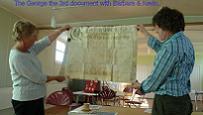STOKESLEY’S HERITAGE - Press Release April/May
 The Stokesley Society’s Heritage Project, supported by a Heritage Lottery Fund Grant, will be holding the next workshop on Monday 21 May at 10 am in St Josephs Church Hall. Anyone interested in exploring Stokesley’s Heritage is welcome to participate in these workshops, which are on the third Monday in the month. Since the first workshop in January we have learnt about researching old maps going back to 1720, investigating old newspapers and storing results “in the clouds” on the internet from the Community Archaeologist, Kevin Cale. In addition there has been a guided tour around the County Records Office and a training course on oral history. The workshops provide a great opportunity to learn from Kevin who has helped similar groups become established in the area.
The Stokesley Society’s Heritage Project, supported by a Heritage Lottery Fund Grant, will be holding the next workshop on Monday 21 May at 10 am in St Josephs Church Hall. Anyone interested in exploring Stokesley’s Heritage is welcome to participate in these workshops, which are on the third Monday in the month. Since the first workshop in January we have learnt about researching old maps going back to 1720, investigating old newspapers and storing results “in the clouds” on the internet from the Community Archaeologist, Kevin Cale. In addition there has been a guided tour around the County Records Office and a training course on oral history. The workshops provide a great opportunity to learn from Kevin who has helped similar groups become established in the area.
The main focus now is on preparing heritage leaflets for publication in the autumn focusing on:
- The massive flax mill behind Levenside (now Armstrong Richardson’s Mill) which was built in the 1830s. It was a brave venture but ended in boom and bust. We are exploring the story of this mill with another that was behind Barclays Bank, and the families involved. We are also exploring working conditions (which involved children under the age of 12), the importance of flax in the region with the first British process for mechanised spinning of flax invented in Darlington, and how the character of Stokesley changed during the Industrial Revolution, which transformed this region. (Contact: Hugh Charman, tel 01642 710507).
- The impact of the Manor of Stokesley on the development of the township over the centuries and features of this impact still visible in Stokesley today. These include field systems and boundaries, pathways, the Town Hall, Shambles, Manorial land and the development of the Manor house and its grounds, with significant changes after WW2. The medieval layout of the town as we know it today is being explored using charters and wills, the changes to the township by the manor, looking at Tithe maps, Hearth Tax returns, auctions of the manor. (Contact: David Maudsley, tel 01642 712760).
- Buildings and their occupants: for example, Oaklands was owned by John Pratt with his printing empire situated at the rear, employing many locals and producing many publications from bibles to novels. One of his employees, a nine year old boy, was flogged for stealing two penny's worth of glue. Garth House was the Head Quarters of The Yorkshire Rifles. The now dining room was the armoury with rifles placed in racks all around the room. Another aspect is the role of the railway in Stokesley’s development. A short list of ten buildings have been chosen, and with five allocated to individuals for research. (Contact: Frank Robinson tel 01642 711356).
H B Charman
Later in this three year project, other topics will be studied providing the basis for leaflets, talks and guided walks, also the Primary School will be involved. People interested in participating in the project should check with one of the contacts given above.
H B Charman
Notes to Editors - Heritage Lottery Fund
Using money raised through the National Lottery, the Heritage Lottery Fund (HLF) sustains and transforms a wide range of heritage for present and future generations to take part in, learn from and enjoy. From museums, parks and historic places to archaeology, natural environment and cultural traditions, we invest in every part of our diverse heritage. HLF has supported 30,000 projects, allocating £4.7billion across the UK, including £364m to 2,729 projects in Yorkshire & the Humber alone. To see their website, please click here.